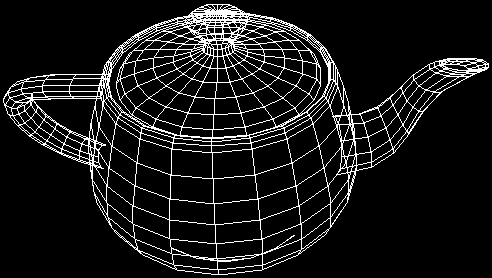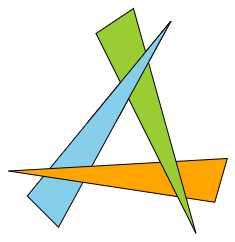Note: GitHub doesn't seem to support SVG SMIL animation in readme previews, until I develop a SVG CSS animator, please click the empty space above to go to the SVG file preview directly.
This application allows for creation of SVGs depicting wireframe 3D scenes with true perspective. It is useful for generating educational and instructional SVGs which can be included in MarkDown documents and rendered in GitHub and VS Code MarkDown previews. Interactive scenes which host SVG in HTML are also supported.
Why pursue the SVG route to animation when WebGL and HTML canvas exist?
SVG is the only alternative to GIF animations when it comes to embedding them in MarkDown documents which can be previewed on GitHub and in VS Code. GIFs are ugly, large and slow. Some animation sharing sites already replace them with MP4 videos or WebP, but that's not an option for MarkDown (although maybe WebP is?).
I want a solution to hosting animated education and instructional content in MarkDown documents which can be hosted and previewed on GitHub and in VS Code. The ability to inspect the source of the animation and tweak it if desired is a huge bonus, and so it the vector based nature of SVG compated to rasters. So, even if WebP might be an option (I haven't checked its support in browsers and on GitHub and in VS Code previews), it is a raster which is worse in terms of tinkering with it.
Since SVG can also be hosted in HTML, there is a potential for interactivity and I am somewhat entertaining this functionality, too, but it is a side-effect of the animation focus, not a sole motivation.
The SVG image can be hosted in HTML as well, allowing for the use of JavaScript to tweak the scene in effect enabling animation and interactivity options.
This application supports reconciling existing SVG DOM instead of mounting a new SVG DOM on each render, improving the performance of JavaScript-based usages. However, where possible, having an unchanging count of vertices, faces and edges in the scene provides the best performance as it fully cuts down on DOM tree mutation and limits the interactivity to the SVG DOM attribute updates.
Theoretically, animations could be made at least somewhat interactive using SMIL animation triggers (and maybe CSS animation using pseudo-states), but that's not an avenue I am pursuing at the moment.
Aside from using JavaScript to provide animation and interactivity to the scene,
an SVG based animation solution can also be used. This will preserve the effect
even when not manipulated using JavaScript, such when displayed using an img
element or when embedded in a MarkDown document and viewed in GitHub or VS Code
MarkDown preview.
Two "engines" for animation are available: SMIL and CSS.
The animate SVG element is used to rearrange the shapes to create an illusion
of motion. Each vertex, edge and face is included once in the SVG and animated
this way. This produces small SVGs, however, GitHub lacks support for rendering
the animation when previewing MarkDown files which use the SVG as an image.
At the moment, SMIL animation support is as follows:
| Context | Support |
|---|---|
| GitHub SVG file preview | Yes |
| GitHub MarkDown file with SVG image preview | No |
| VS Code MarkDown file with SVG image preview | Yes |
I have contacted GitHub support about the missing support in MarkDown previews as it is inconsistent with the fact that SVG file preview renders the animation.
I will update this document whenever I hear back.
This type of animation benefits from the amount of vertices, edges and faces staying constant during the course of the animation, because I have not yet implemented adding and removing shapes using SMIL and am not certain that is even possible. If it isn't, it could still be supported by mixing SMIL and CSS animation, however, so this will eventually be supported one way or another.
CSS in SVG animation can be used, however it is limited to animating layout
properties, not general SVG attributes. This means that instead of animating
vertices, edges and faces by changing their values, these shapes need to be
duplicated in the animation for each frame and shown and hidden using the
display CSS property. This results in large files, but is supported in GitHub
MarkDown previews unlike the SMIL based solution, so both ways are currently
supported until GitHub begins to support SMIL animation in MarkDown previews.
At the moment, CSS animation support is as follows:
| Context | Support |
|---|---|
| GitHub SVG file preview | Yes |
| GitHub MarkDown file with SVG image preview | Yes |
| VS Code MarkDown file with SVG image preview | Yes |
The performance of the animation is up to the SVG renderer used. I am working on browser SVG renderer peformance comparison to provide some hard numbers on this.
Additionally, JavaScript-interactive usages will incur a performance overhead in the form of DOM.
Both WebGL and canvas are accelerated, so both will be either more performant
or at best as performant as an SVG based animation, and in case of JavaScript-
interactive SVG scene, will likely always be more performant as they never
involve the DOM in the process.
To learn more, see Performance and to see why I am pursuing this direction anyway, see Motivation.
See Animation to learn about the support of the individual engines in GitHub and VS Code MarkDown previews.
Outside of those contexts, the support depends on the SVG renderer used and its support for SMIL and CSS depending on the animation engine choice.
This is a personal, spare-time project. I work on it when I have the time I want to dedicate to this particular project. I don't work on it assuming anyone else uses this or cares about this. In that way, this is more of a souce-available type project as opposed to an actual open source project with a community.
If you find a use for this, let me know.
There is Z-Dog and also a lot of other people's pet projects having to do with SVG and 3D.
Right now they sit in render. Once the rotate function is in esm-matrix,
add one for translation and then a combining one for rotation around origin and
use those in index to position the model before rendering it. Rendering will
then only accept camera position and orientation and the mesh with its transform
array.
It renders an empty SVG in the readme preview on the repo home page, but going
to the screencast file page directly, the preview there renders the SMIL
animation. If this ends up being unsuppoted by GitHub, definitely support both
SMIL and CSS animators and use the CSS animator in the readme, which I already
know works, because I've used in
svg-screencast.
Also see if this is true only for the readme or any MarkDown preview.
Dynamic would host the SVG whose DOM gets updated using requestAnimationFrame
and static would host the SVG with baked animation which only gets updated when
the animation parameters change.
Either UI controls or 2D to 3D cursor approximation.
Add translate, scale, skew. Move these either to the esm-matrix library or a
whole new library.
Find a way to render edges as polylines or multiple line elements whose strokes gradually vary in relation to their depth respective to the camera.
If there is no way to do this using a polyline and multiple lines have to be used, it is not a good fit for this project, as in this project, a static number of DOM elements in the SVG is one of the goals, but it will still be cool to have this as an experiment somewhere.
Reset only when a user interaction happens (unsupported at the moment, so we would only be animating the time). This might not be economical, so keep the mount+reconcile flow as an alternative / the sole solution if this doesn't work out.
Example tesselators: box, prism, sphere (of tris, quads, spool-like stripes, …). Also the Utah teapot and maybe Suzanne depending on complexity.
Wavefront OBJ supports a l element so it can be used.
This is the standard in 3D and video game industries so it might make sense to adopt it if I want to make this robust eventually.
SVG has a few interesting bits related to stroke and fill styling. Perhaps these could be used to implement wireframe or even textured edge and face culling.
https://en.wikipedia.org/wiki/Back-face_culling
In the image here, culled shapes are hidden, but they could also be made semi- transparent etc.
For this to work, the shapes need to be rendered back to front to begin with, which should be just a matter of sorting them that way when inserting to the fragment and rearranging them when reconciling. Not sure how to do this in the SVG or CSS in SVG animation if I get around to that.
Something like this could be then made to work:
The triangles, at the place where they overlap, would use a fill mask to implant the texture from the shared area of the shape that overlaps them at that area.
Another thing this could help enable would be to hide shapes which are fully or partially behind the camera. Right now they appear and are distorted. When only partially outside (or behind) of the viewport, the Bresenham algorithm could be used on the edges of the face (in case of a shape with an area) in order to sort of "ray-trace" the length of the edge until it meets the edge and then use the above techniques to cull the rest of the edges and mask away the hidden portion of the shape's fill.
Useful links for this:
- https://brm.io/matter-js
- http://wellcaffeinated.net/PhysicsJS
- http://piqnt.com/planck.js
- https://github.com/lo-th/Oimo.js
- https://github.com/kripken/box2d.js
See how these are in terms of integration with 3rd paties. I don't want their rendering and I want to be able to simply send in the meshes in a basic format instead of adopting something which is too complex for my needs.
It would also be useful to filter out those which support dead body indication so I could use that as a marker for the end of an animation when doing animation in the SVG or using CSS in SVG.
I will have to research this, but I believe an ellipse in 3D might still be representable using an ellipse in 2D even accounting for its orientation and perspective distortion. And if not an ellipse, perhaps a combination of ars, say two Beziers making up a single ellipse?
The question is whether it is worth the effort, if the reduced DOM node count will matter when faced with the rasterization complexity of ellipses as opposed to polylines (is it more expensive?).
Mutating the matrices in place is faster than generating new instances and replacing the references, so all matrix operations will need to be updated to reflect this.
This is so that I am able to switch around the render logic and run it through it and it would run it a few times and collect the performance metrics and then I could compare them.
Puppeteer has a profiling API which will be very useful for this and I should
also be able to maybe control requestAnimationFrame rate if I need that.
The WIP version is much faster, because it cuts down on allocations, but I made a mistake somewhere and now the mesh slides towards the origin as it rotates.
Chrome, Firefox and Safari might all be supported. Capture a series of frames
from the SVG playback and compare them to the known baseline set of images made
by making animate yield the individual frames and track how much each frame
got delayed or not.

